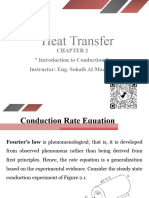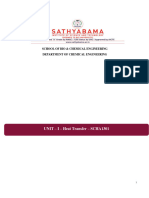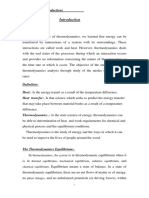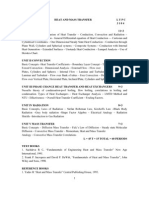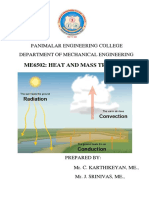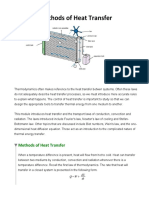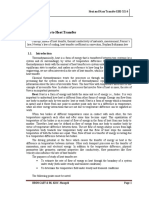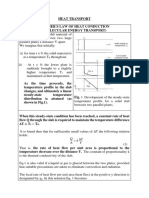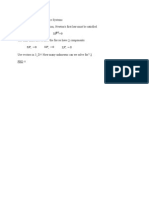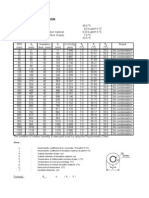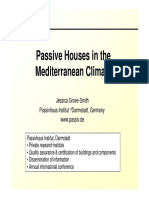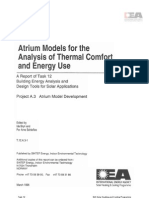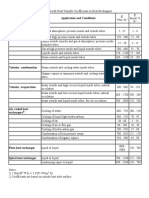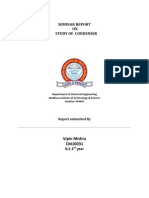Conduction HMT
Conduction HMT
Uploaded by
balakaleesCopyright:
Available Formats
Conduction HMT
Conduction HMT
Uploaded by
balakaleesOriginal Title
Copyright
Available Formats
Share this document
Did you find this document useful?
Is this content inappropriate?
Copyright:
Available Formats
Conduction HMT
Conduction HMT
Uploaded by
balakaleesCopyright:
Available Formats
Q. 2.1. State the Fourier law of heat conduction.
Clearly mention the various assumptions under which this law is applicable. Ans. Whenever, a temperature difference exists in a body, there is an heat transfer from high temperature region to low temperature region by conduction. The Fourier law states that the rate of heat conduction per unit area (heat flux) is directly proportional to the temperature gradient.
Where, Q = rate of heat transfer (W) A = heat transfer area in m2 r*xnI w dirtkzi of heat flow.
k= constant of proportionality, called the thermal conductivity of material (W/mC or W/mK) The minus sign is inserted to make the natural heat flow, a positive quantity. According to the second law thermodynamics, the heat always flows in the direction of decreasing temperature, thus the temperature gradient becomes negative. The Fourier law is essentially based on the following assumptions; steady state conduction heat transfer one directional heat flow bounding surfaces are isothermal in character i.e., constant and uniform temperatures are maintained at the two faces isotropic and homogeneous material constant temperature gradient and a linear temperature profiles. no internal heat generation. Q. 22. Give electrical analogy of heat transfer by conduction. Or Explain the concept of thermal resistance. Ans Observations indicate that in systems involving heat and electricity, the flow quantity is directly proportional to the deriving potential and inversely proportional to the flow resistance. From Ohms law I = V/R and from Fouriers law of heat transfer
As potential difference across a resistance makes the current to flow similarly temperature difference across a solid makes the heat tcjpw. Obviously there is a one- one correspondence between the flow of electric current and heat i.e., Electric current is.ana1ogcu.is to thermal heat flow rate Electrical voltage corpon to thermal temperature difference. Comparing equations (1) and (ii) electric resistance is analogous to quantity dx,4cA. This quantity is called thermal resistance. So, Thermal Resistance R =
Q. 2.3. What is the effect of temperature on thermal conductivity of metals? Ans.
Thermal conductivity of a material is the outcome of migration of free electrons and lattice vibration waves. In metals the molecules are closely packed molecular activity is rather small and so thermal conductivity is substantially due to the flow of free electrons. At elevated temperature, thermal vibration of the lattice becomes higher and that retards the motion of free electrons. Consequently thermal conductivity of most metals decreases with temperature growth; aluminium and uranium are the exceptions. Thermal conductivity of aluminium stays almost constant within the temperature range of 130C to 370C. Most of the outer electrons of the uranium atoms are tied up in covalent bonds and as such the contribution of free electrons to the conduction process is small.
Conduction of heat within uranium depends mainly on the vibration of atoms. The vibration tendency increases with temperature rise and so does the thermal conductivity of uranium.
Q. 2.4. How does the temperature effects the thermal conductivity of gases and liquids Ans. For gases: Heat transfer by conduction in gases occurs through transport of the kinetic energy of molecular motion resulting from the random movement and collisions of the molecules. From the concept of kinetic theory, mean travel velocity V of the gas molecules is prescribed by the relation:
where G is the universal gas constant, M is the molecular weight of the gas and T is the absolute temperature. Thermal conducth ity is worked out from the relation.
where 1 is the mean free path (average distance travelled by a moule before experiencing collision) C, is the specific heat at constant volume and p is the mass density. Experimental investigations show that with incr. ii p-c-..the gas density increases; while the mean free path diminishes in the invest proportion. However, the product (p1) practically remained constant indir2ting there by that thermal conductivity of gases does not depend upon prewe. So with increase in temperature thermal conductivity of gases increases attributed by the ftors ; mean travel velocity and specific heat. For liquids : For liquids, the thermal conductivity is governed by the relation:
The parameter A depends not on the nature of the liquid but on the temperature ; the quantity (Ace) is nearly constant for all liquids. As temperature of gas increases its density p decreases and hence the thermal conductivity i.e., thermal conductivity of liquids decreases with rise in temperature. Q. 2.5. Is there any relation of thermal conductivity value of a gas with its molecular weight ? Or What is the effect of molecular weight on thermal conductivity of a gas? Ans. Thermal conductivity of gas is governed by the following equation:
Where mass density and Ce specific heat at constant volume. Above relation show that has more value for a gas with low molecular weight and hence thermal conductivity will be higher for a gas with lower molecular weight, other parameters remaining constant. For example; K for hydrogen (mol. weight = 2) = 0.190 W/mK. K for oxygen (mol. weight = 32) = 0.0272 W/mK. Q. 2.6. What do you mean by Thermal Diffusivity? Ans. Thermal diffusivity denoted by a of a material is the ratio of its thermal conductivity K to the thermal storage capacity pc i.e. weight, T is absolute temperature, is mean travel velocity, 1 is the mean free path, p
The following reflections can be made with regard to a (i) The heat storage capacity represents sluggishness of the material to conduct heat. A high value of thermal diffusivity could result either from a high value of thermal conductivity or from low value of thermal capacity. Liquids have a low thermal conductivity, high thermal capacity and hence small thermal diffusivity. Metals possess high thermal conductivity, low thermal inertia and hence large thermal diffusivity. (ii) Larger the thermal diffusivity, higher would be the rate of change of temperature at any point of the material. Equalization of temperature would then proceed at a higher rate in materials having large thermal diffusivity. Q. 2.7. Derive general heat conduction equation in Cartesian co-ordinates. Ans. Cartesian Co-ordinates : Consider the flaw of heat through an infinitesimal volume element oriented in a three-dimensional co-ordinate system (Fig. 12). The sides dx, dy and dz have been taken parallel to the x,y and z axis respectively.
The general conduction equation can be set up by applying Fourier equation in each cartesian direction. If k represents the thermal conductivity at the left face, then quantity of heat flowing into the control volume through this face during time interval dt is given by
During the same time interval the heat flow out of the right face of the control volume will be,
Accumulation of heat in the elemental volume due to heat flow in the x-direction is given by the difference between heat influx and heat efflux. Thus the heat accumulation due to heat flow in xdirection is
Likewise the heat accumulation in the control volume y-and z-directions will be: due to heat flow along the
Sum of heat accumulations as prescribed by equations (1), (ii) and (iii) gives the total heat stored in the elemental volume due to heat flow along all the co-ordinate axes. Total or net accumulation of heat is equal to
If q is the heat generated per unit volume and per unit time, then the total heat generate in the control volume equals to qg dx dy dz dr .. .(vii) The total heat accumulated in the lattice due to heat flow along all the co-ordinate axes Eq. (vi) and the heat generated within the lattice Eq (vii) together serve to increase the thermal energy of the lattice. This increase in thermal energy is given by:
where p is the density and c is the spedfic heat of the material. Thus from energy balance considerations
Equation (viii) represents a volumetric heat balance which must be satisfied at each point for self generating, unsteady state three-dimensional heat flow through a non-isotropic material. This expression, known as the general heat conduction equation. Homogeneous and isotropic material:
A homogeneous material implies that the properties i.e., density, specific heat and thermal conductivity of the material are same everywhere in the material system. Isotropic means that these properties are not directional characteristics of the material, i.e., they are independent of the orientation of the surface. Therefore for an isotropic and homogeneous material thermal conductivity is same at every point and in all direction. In that case = k, = = k and the differential equation (viii) takes the form.
The quantity a = k/pc is called the thermal Uay. Q. 2.8. Derive general heat conduction eqn. ii cylindrical co-ordinates. Ans. Cylindrical Co-ordinates: When heat occurs through systems having cylindrical geometries (e.g. conduction through rods and pipes) it is considered more convenient to work in the cylindrical co-ordinates. The general heat equation can be set up by considering an infinitesimal cylindrical al volume element. Refer Fig. 2.3. dV = (dr rdr,b dz) and writing energy balance equations in the radial, tangential and ixia1 directions. (a) Radial direction (x9 plane) Heat influx
Heat efflux Heat stored in the element due to flow of heat in the radial direction. Heat influx (b) Tangential direction (rz plane):
Heat efflux
Heat stored in the element due to flow in the tangential direction,
(c) Axial direction (r plane): Heat influx
Heat ef flux
Heat stored in the element due to heat flow in axial direction,
Heat generated within the control volume Rate of change of energy within the control volume
From energy balance considerations, the rate of change of energy within the control volume equals the total heat storage plus the heat generated. Therefore,
Dividing both sides by dV dx
which is the general heat conduction equation in the cylindrical co-ordinates. Q. 2.9. Derive general heat conduction equation in spherical co-ordinates. Ans. Spherical Co-ordinates The general heat conduction equation in spherical co-ordinates can be set up by considering an infinitesimal spherical volume element and writing the heat balance equation for the r, 0 and 0 directions.
(a) Heat flow through r - 0 plane ; direction: Heat influx
Heat efflux
Heat stored in the elemental volume due to heat flow in the direction
(b) Heat flow through r -, plane ; 0 dIrection: Heat influx
Heat efflux
Heat stored in the elemental volume due boat flow in the 0-direction
(c) Heat flow in the 0 , plane ; r - direction: Heat influx
Heat efflux
Heat storage in the elemental volume due to heat flow in the r-direction
Heat generated within the control volume = q8 dV dr Rate of change of energy within the control volume
From energy balance consideration, the rate of change of energy within the control volume equals the total storage plus the internal heat generation. Therefore,
Dividing both sides by k dV dr
The which is the general heat conduction equation in spherical co-ordinates. Q. 2.10. Give various examples where internal heat generation takes place in conducting medium itself. Ans. In many situations of practical importance, heat is generated internally at uniform rate within the conducting medium itself. Notable examples are (i) Resistance heating in electrical appliances ; essentially it is the conversion of electrical energy into thermal energy in the current carrying medium. (ii) Energy generated in the fuel element of a nuclear reactor. (iii) Liberation of energy due to some exothermic chemical reactions occurring within the medium. (iv) Drying and setting of concrete. Temperature distribution within the medium and the rate of heat depiction to the surroundings assume great importance in the design of thermal units. Q. 2.11. Derive a relation for temperature distribution and heat flow rate in the plane wall with a uniformly distributed heat generation. Ans. Plane wall with uniform heat generation: Consider heat conduction through a plane wall in which heat sources are uniformly distributed over the entire volume. The wall surfaces are maintained at temperature t1 and t2, and the wall thickness 6 is small in comparison with other dimensions.
Considering the general heat conduction equation in cartesian co-ordinates.
This equation is restricted by following assumptions: Assumptions: 1. Steady state conditions i.e.,
1. One-dimensional heat flow in x-axis direction only
3. Constant thermal conductivity k. 4. Uniform volumetric heat generation (q per unit volume) within the wall. The general heat conduction equation reduces to
Integrating equation (I), we obtain the general solution as
Constants of Integration are found by considering following two cases:
CASE I. Both surfaces are maintained at a common temperature: (Refer Fig. 2.5 (b).) From the prescribed boundary conditions,
the constants of integration take the values
Substituting these values of C1 and C2 in equation (Ill), the expression for temperature profile becomes
Maximum temperature and its location within the wall can be worked out by differentiating the equation for temperature profile with respect to x and equating the derivative to zero.
The temperature distribution as prescribed by equation IV is thus parabolic and symmetrical about the mid plane. Maximum value of temperature occurs at x = 6/2 and it equals
Heat transmission then occurs towards both sures and fo each surface it is given by:
For both surfaces = (volume of conducting medium) CASE II : Temperatures of both the surfaces are different: When the boundary conditions
are applied to equation III, the constants of integration take the values
Substituting these values of integration constants in equation Ill, the expression for temperature profile becomes;
Further, rate of heat flow from any face of the wall is;
Heat flow from the left hand face, i.e., at x 0
Heat flow from the right hand face i.e., at x = 6
Let us now examine two cases (1) Maximum temperature occurs within the wall; the heat flow will then be from both the surfaces and the total heat flow will become (ii) = Q1 + Q2 Maximum temperature occurs at the left hand face, i.e., t1 is maximum; the heat flow will then be only towards the right i.e., in the direction of falling temperature = Q2 (only)
If there is no internal heat generation (i.e., qg = 0), the above expression reduces to heat conduction equation Q = kA (t1 - t2)I6 for a plane wall without any internal generation of energy. Q. 2.12. Derive a relation for temperature distribution in the piston crown. Ans. Heat transfer through the piston crown : With reference to Fig. 2.6, let R = outer radius of piston, b = thickness of piston crown = outer surface temperature of piston material, k thermal conductivity of piston material, = convection and radiation heat flux (heat transfer per unit area) from the gases to the piston.
[he appropriate differential equation describing the temperature distribution can be obtained by making an energy balance on a cylindrical element of thickness dr and radius r. Q (heat conducted in at radius r) =
Qg (heat given by the gases to the element dr) =
(heat conducted out at radius r + dr) =
For steady conduction of heat flow,
This yields the appropriate form of heat equation as
Upon integration
Another integration gives the general solution for temperature distribution.
The constants of integration are determined from the relevant boundary conditions which are (1) dt/dr = 0 at r = 0; because temperature is maximum at r = 0 (ii) t t0 at rR Using expression (ii) C1 = 0 Applying the boundary condition t = t0 at r R to expression (iii) and noting that C1 = 0, we get
With these values .of integration constants, the expression (iii) for the temperature takes the form
Undoubtedly the temperature distribution is parabolic and the maximum temperature occurring at the centre of piston (r = 0) is given by
If Q denotes the total heat given by the gases to the piston crown, then
The above expression is used for calculating tt desired thickness of piston crown
Q. 2.13. Establish a relation for temperature distribution in Nuclear fuel element without cladding and with cladding. Ans. Nuclear fuel elements without cladding The heat generation due to fission within a nuclear fuel element (cylindrical in shape) is generally given by
where q0 is the heat generation rate per unit volume at the centre (r 0) and R is the outer radius of the solid fuel rod. Evidently qg is a fanction of position r, i.e., the radial distance from the axis of the rod. For steady state one-dimensional heat conduction in the radial direction, we have (from general heat conduction equation in cylindrical co-ordinates)
Upon integration
Or
Integrating again,
Boundary conditions
With these values of integration constants, the expression (3) for the temperature distribution takes the form:
The heat flow at the surface of the rod is,
Nuclear fuel element with cladding. The fuel elements of a nuclear reactor are likely to get damaged due to oxidation, if these elements come in direct contact with the cooling medium. To prevent this damage, the fuel elements are usually lagged on the outside with a protective material called cladding. The heat generated rate per unit volume in the fissionable (fuel rod) material is given by
where is the generating rate at any radius r, q0 is the heat generating rate at the centre of fissionable element, R and RL are the outside radii of fuel rod and cladding respectively.
The temperature distribution within the fissionable element and tl dadding can be worked out from the following steady state one- dimensional heat conduction equation
Q/A)is The heat flux q (heat flow per unit area,
Assuming thermal conductivity k to be constant and with substitution of dt/dr = - the basic governing equation becomes
Let the fuel rod and the cladding be denoted by f and c respectively. Then,
and as there is no internal generation in cladding
Integrating expression (6),
and upon integration of expression (7) we ottain
Applying the boundary conditions qj=finite at r=O qj q at r= Rf The integration constants workout as CI =0
Accordingly the heat flux through fuel rod and cladding may be rewritten as
The temperature tj and t can be obtained by integration of the above identities.
Applying the boundary condition t = (outside surface temperature of the system) at r = R
Applying the boundary condition t = tjat r = RrtO expression (12) and substituting there in the value of t as evaluated above, we get
The maximum value of tf occurs at the centre of fissionable material, i.e., at r = 0 and would be given by
Q. 2.14. Derive expressions for temperature distributions, under one dimensional steady state heat conduction for the following cases: (I) Plane wall (II) Cylinder (III) Sphere. Ans. (I) Plane wall : The general heat conduction equations in cartesian co-ordinates is given by : 1
Now refer Fig. 2.9 which represents a plane wall of thickness 6 having temperatures t1 and 2 on its two surfaces considering the following constraints:
1. Steady state heat flow such that =
1. No internal heat generations, qg = 0 So equation (1) reduces to;
2. 3. By integrating the above equation
Again integrating
Now applying the boundary conditions:
Now, applying these boundary conditions to equation (2)
Putting the values of C1, C2 in equation (2)
This equation gives the variation of temperature w.r.t. distance x along the directional of heat flow, which is a linear relationship. So the temperature profile (a line representing the variation of temperature w.r.t. distance) is represented by a straight line. Now heat transfer through the plane wall can be found by using Fouriers equations.
(II) Cylinder: The general heat conduction equation in cylindrical co-ordinates is given r:
Now refer fig. 2.10 which represents a cylindrical shell of internal radius r1 and external radius r2 with inner temperature t1 and outside temperature t2. Heat transfer through this cylindrical shell is put by following constraints:
So, the equation (3) reduces to
Now, taking integration of above equation
Again, integrating
Now apply boundary conditions:
Applying these boundary conditions to equation (4)
Putting value of C1 in equation (A);
Putting the values of C1 and C2 in equation (4)
This equation gives the variation of temperature w.r.t. radius of cylindrical shell. Equation represents that the temperature variation is logarithmic for cylindrical shell. Now heat transfer Q
where R, = Thermal resistance =
(III) Sphere: The general heat conduction equation for spherical co-ordinates is given as
Now refer fig. 2.11 which represents a spherical shell with inner radius r1 and outer radius r2. The temperature on the inside is t1 and at outside is t2. Now applying the following constraints for the heat transfer through the shell
1. Steady state heat transfer i.e.,
(ii) No internal heat generation i.e., (iii) One direction heat transfer, only in the radial direction i.e.,
From equation (5)
Integrating this equation
Again integrating
Now, applying boundary conditions:
Applying above boundary conditions to equation (6)
Puffing the value of C1 in equation (D):
Puffing the value of C1 and C2 in equation (6)
From equation (7) it is evident that the temperature distribution associated with radial conduction through a spherical shell is represented by a hyperbola. Now, Q = heat transfer rate
where R1 = thermal resistance for spherical shell
Q. 2.15. Derive expression for one dimensional, steady state heat conduction for composite plane wall. Ans. Refer Fig. 2.12 It represents a composite wall made up o three different layers of tjinss.6 and 63 with thermal conductivities respectively. This composite wall is exposed to temperature 11 on one side and t2 on other side such that the temperature at the interfaces are ia and tb. Since the heat transfer rate through each layer is same, we have,
Rearranging the above expression, we get;
Adding (i), (ii) and (iii), we have
= Temperature difference across the composite wall Total thermal resistance If the composk wall consists of i layers, then;
Ans. Refer Fig. 2.13. Q. 2.16. What do you mean by Thermal contact resistance? Ans. Refer Fig. 2.13. In the analysis for heat flow through a composite wall it is assumed that the contact between layers is perfect. But in real system, due to surface roughness and void spaces (usually filled with air) the contact surfaces touch only at discrete locations i.e., there is no single plane of contact, which means that the area available for the flow of heat at interface will be small compared to geometric surface area. Due to this reduced area and presence of air voids, a larger resistance to heat flow at the interface occurs. This resistance is known as thermal contact resistance and it causes temperature drop at the interface as shown in the fig. The contact resistance is given by
Q. 2.17. What do you mean by Logrithmic mean area or equivalent area for the hollow cylinder? Ans. Refer Fig. 2.14, (a) and (1,)
Heat transfer for hollow cylinder
Heat transfer for plane wall having thickness d = r2 r1 is
If both the hollow cylinder and plane wall transfer same rate of heat transfer with same material and temperature difference across the wall, then
Am is so chosen that the heat flow through cylinder and plane wall will be equal for the same temperature difference across the wall.
where A1 and A0 are inside and outside surface areas of the cylinder. The expression is known as logarithmic mean area or equivalent area of plane wall or hollow cylinder. Q. 2.18. Explain the concept of critical thickness of insulation. Ans. The addition of insulation in some cases may reduce thermal resistance due to the reduction in convective thermal resistance because of increase in surface area as in case of cylinder and sphere. It may be shown that the thermal resistance actually decreases and then increases in some cases with the addition of insulation. The thickness upto which heat flow increases and after which heat flow decreases is termed as critical thickness. In case of cylinders and spheres it is called Critical radius. Let us consider a hollow cylinder provided with in insulation with inner radius r, and outer radius r as shown in Fig. 2.15.
Total thermal resistance offered by the insulation,
When r radius of insulation increases it will increase the second factor and decrease the third factor in the above equation. The R i.e., thermal resistance will be maximum at a radius where.
This r is written as Ti, called critical radius ct insulation of cylinder.
We can see from the graph (Fig. 2.16) between R and r that when r < rc, thermal resistance decreases with increase in r upto r i.e., heat transfer rate increases. r > r, thermal resistance increases with increase in r i.e., heat transfer decreases.
Q. 2.19. What is the significance of Critical radius? Of insulation in design of insulations for a stean pipe and an electric wire. Ans. Critical radius of insulation is that radius up to which the heat transfer rate increases and beyond that it start decreasing as shown in the fig. where r is the critical radius of insulation. These are some applications like steam pipe in which we want to prevent the heat to pass through the wall but on the other side there is an application like electric wire in which we are bound to put insulation to avoid electric shock but at the same time want to increase the heat dissipation to keep it cool. By using the concept of critical thickness of insulation we can meet the above requirement as follows Design of insulations for steam pipe : The outer radius of insulation for steam pipe 7 is always kept greater than re because heat transfer after rate decreases beyond re. Design of insulation for electric wire : Radius of insulation for electric wire (r) to kept less than re in order to increase the ratio of heat dissipation. Formulae used for the solution of numerical problems: 1. Heat transfer by conduction
Design of insulations for steam pipe : The outer radius of insulation for steam pipe 7 is always kept greater than re because heat transfer after rate decreases beyond re.
Design of insulation for electric wire : Radius of insulation for electric wire (r) to kept less than re in order to increase the ratio of heat dissipation. Formulae used for the solution of numerical problems: 1. Heat transfer by conduction
where t Temperature difference across the wall R - Thermal resistance (a) For plane wall
(b) For cylindrical wall
(c) For spherical wall
Heat transfer by conduction through a composite wall (when the walls form a series system of resistance)
Thermal resistance offered by fluid having convective heat transfer coeff or film coeff. h = 1/hA
Q. 2.20. One of the surfaces of a plane wall is at 60Cand the other is at 35C. Calculate the rate of heat transfer per m2 of surface area of the wall which is 22cm thick. The thermal conductivity of the brick is 0.51 W/mk. Ans. Given t1 = 60C, t2 35C
d = 22 cm = 0.22 m k= 0.51 w/mk A=1m2 Required Q=?
(60 -35) 0.22/0.51x1
0.51 x (60-35) 0.22
Q = 57.95 w/m ans
Q. 2.21. The insulation boards for air conditioning purposes are made of three layers, middle being packed grass 10 cm thirk (k = 0..02w/mk) and the sides are made of plywood each 2 cm thickness (k = 0.12 w/mk).. Determine the heat flow per m2 area if one surface is at 30C and other surface is JC. Ans. Given: Refer Fig.
= 2cm = 0.22 m = 10cm = 0.lOm = 2cm = 0.02m
= 0.12 w/mk = 0.02 w/n,k
= 30C, = 20C
A=1m2 Required : heat transfer Q = ? We know that;
0.02 + 0.12 x1 = 5.334 From (1)
0.1 + 0.02 x1
0.02 0.12x1
Q = 2.81 w/m2.
Q. 2.22. A mild steel tank of wall thickness 12mm contains water at 95C. Thermal conductivity of mild steel is 50 W/mk and the heat transfer coefficients for the inside and outside the tank are 2850 and 10 w/m2k respectively. if the atmospheric temperature is 15C calculate: (a) the rate of heat loss per m2 of the tank surface area (b) the temperature of the outside surface of the tank. Ans. Refer Fig
= 12 mm = 0.012 m =95C =15C K=50w/mk Heat transfer coeff. side = h., = 2850 W/m2k inside i.e., on water w/m2k Heat transfer coeff on air side ha = 10 area 1. Rate of heat loss per m2 of tank surface
___1____ + 2850 x 1
0.012 + 50 x 1 795.2 W/m2
1 10 x 1
Q = 95 15 0.1006
(b) Temperature of outside surface We know that
Q. 2.23. Calculate the rate of heat flow per m2 through a furnace wall consisting of 200 mm thick inner layer of chrome brick, a centre layer of kaolin brick 100 mm thick and an outer layer of masonary brick 100 mm thick. The unit surface conductance at the inner surface is 74 W/m2k and the outer surface temperature is 70C. The temperatures of the gases inside the furnace is 16700. What temperature prevail at the inner and outer surfaces of the centre layer?
Ans. Refer Fig.
= 200 mm = 0.22 m =100 mm = 0.1 m = 100 mm = 0.1 m
( temperature of gases inside furnace) = 1670 t2 (outer surface temperature) = 70C
Rate of heat flow per m2, Q;
1 + 74 x 1
0.2 + 1.25 x 1
0.1 + 0.1 0.74 x 1 0.555 x 1
= 0.0135 + 0.16 +1.351 +0.1802
= 1.7047
Q = 1670 70 1.7047 =938.58W/rn2 Temperatures t and t1 We know that heat flow rate through each layer is same, o;
You might also like
- 18ME63 H T NotesDocument97 pages18ME63 H T NotesTSB Inferno100% (1)
- Determination of Dryness Fraction of SteamDocument11 pagesDetermination of Dryness Fraction of SteamRohit Ketkar100% (2)
- Analysis and Design of Heating, Ventilating, and Air-Conditioning Systems'' PDFDocument477 pagesAnalysis and Design of Heating, Ventilating, and Air-Conditioning Systems'' PDFMoh'd Khad100% (5)
- Module 3Document3 pagesModule 3grittyptNo ratings yet
- Heat Transfer: The Conduction Rate EquationDocument6 pagesHeat Transfer: The Conduction Rate EquationOmer Ghassan Abdulkareem Hassan AlsultanNo ratings yet
- GATE Tutor (ME) - Heat&Mass Transfer 1Document30 pagesGATE Tutor (ME) - Heat&Mass Transfer 1SabariMechy0% (1)
- Heat Transfer Ch.2Document48 pagesHeat Transfer Ch.29phwtqf6fzNo ratings yet
- 11 Heat TranferDocument130 pages11 Heat Tranferjillellapranay2No ratings yet
- Scha1301 - 033251 1 65Document65 pagesScha1301 - 033251 1 65danifexNo ratings yet
- Heat and Mass Transfer Module 1 Lesson 2Document13 pagesHeat and Mass Transfer Module 1 Lesson 2cool kidNo ratings yet
- Steady Heat Conduction-1Document20 pagesSteady Heat Conduction-1kanyamahazawilsonNo ratings yet
- Heat 1Document17 pagesHeat 1shotlove56No ratings yet
- Introduction To Heat Transfer PresentationDocument43 pagesIntroduction To Heat Transfer Presentationlopiga21203827mNo ratings yet
- Group 2 ConductionDocument19 pagesGroup 2 ConductionVidal Lovely O.No ratings yet
- Introduction To Heat Transfer: Reference BooksDocument67 pagesIntroduction To Heat Transfer: Reference BooksVaishnavi MandhaniNo ratings yet
- Lectures Presented by B.K.Roy Assistant Professor Mechanical Engineering DepartmentDocument40 pagesLectures Presented by B.K.Roy Assistant Professor Mechanical Engineering Departmentreshnalidevi1998No ratings yet
- HEAT and Mass Transfer: Course Code: NME-501Document36 pagesHEAT and Mass Transfer: Course Code: NME-501Chaubey AjayNo ratings yet
- Mee407 1 20232024Document21 pagesMee407 1 20232024Adeboye BusayoNo ratings yet
- ME2251 Uw PDFDocument164 pagesME2251 Uw PDFPon ShanmugakumarNo ratings yet
- Final hmt-1 PDFDocument211 pagesFinal hmt-1 PDFPoyyamozhi Nadesan RanjithNo ratings yet
- Heat TransferDocument11 pagesHeat TransferzulkoNo ratings yet
- GATE Material. Heat Transfer. ChemicalDocument71 pagesGATE Material. Heat Transfer. ChemicalsureshNo ratings yet
- Heat and Mass Transfer NotesDocument364 pagesHeat and Mass Transfer NotesPradeep KumarNo ratings yet
- 2019-Me-22 (Waheed Ul Hassan) 02....Document8 pages2019-Me-22 (Waheed Ul Hassan) 02....Amroz AfzalNo ratings yet
- Heat Transfer Conduction Convection RadiationDocument3 pagesHeat Transfer Conduction Convection RadiationMiftakhulHudaTachulSpentigsUnyilStembaNo ratings yet
- C17H PDFDocument40 pagesC17H PDFramau619No ratings yet
- Methods of Heat TransferDocument17 pagesMethods of Heat TransferSalwanNo ratings yet
- Dr. Amit Rai Department of Chemical Engineering Sliet, LongowalDocument10 pagesDr. Amit Rai Department of Chemical Engineering Sliet, LongowalAmit RaiNo ratings yet
- Heat Transfer Lecture I PDFDocument25 pagesHeat Transfer Lecture I PDFGetachew TikueNo ratings yet
- Topic 3-Heat Conduction EquationDocument51 pagesTopic 3-Heat Conduction EquationAnas AmirNo ratings yet
- Conduction Lecture 1Document33 pagesConduction Lecture 1DUET LIFENo ratings yet
- HMT Module I Mech Ktu AssistDocument39 pagesHMT Module I Mech Ktu AssistJithosh BabuNo ratings yet
- Chapter 1Document11 pagesChapter 1Deepak MahapatraNo ratings yet
- Bio Process Heat TransferDocument25 pagesBio Process Heat TransferlegendofrohithNo ratings yet
- Lesson 5 Conduction - Fourier Law of Heat ConductionDocument24 pagesLesson 5 Conduction - Fourier Law of Heat Conductionsurya kiranNo ratings yet
- UNIT-2 Basics Of Heat Transfer: q = - kA ΔTDocument17 pagesUNIT-2 Basics Of Heat Transfer: q = - kA ΔTSumanranuNo ratings yet
- THERMODocument49 pagesTHERMOJan Resty BenNo ratings yet
- Magpantay, Erol Rexel C.Document3 pagesMagpantay, Erol Rexel C.Kenny KenNo ratings yet
- Heat Transfer Study MaterialDocument100 pagesHeat Transfer Study MaterialMad GamersNo ratings yet
- Chapter 2Document29 pagesChapter 2tafariafessamorodaNo ratings yet
- NOTES-heat-transfer-IntroDocument11 pagesNOTES-heat-transfer-Introsainialpa0No ratings yet
- Introduction and Basic Concepts: Chapter OneDocument16 pagesIntroduction and Basic Concepts: Chapter Oneabdi dejeneNo ratings yet
- CH 1Document3 pagesCH 1Lotfi NaftiNo ratings yet
- Heat and Mass Transfer Lecture Slide: Dr. Paul S. NnamchiDocument34 pagesHeat and Mass Transfer Lecture Slide: Dr. Paul S. NnamchilotannaNo ratings yet
- Fundamentals of Heat TransferDocument20 pagesFundamentals of Heat TransferDayanidiNo ratings yet
- Thermo Exp 6oDocument8 pagesThermo Exp 6oMahrukh ChaudharyNo ratings yet
- Heat Conduction EquationDocument45 pagesHeat Conduction EquationOmar EzzatNo ratings yet
- Heat Transfer 1 PDFDocument72 pagesHeat Transfer 1 PDFMerazka FaroukNo ratings yet
- Basic Modes of Heat TransferDocument15 pagesBasic Modes of Heat Transfermeraj100% (1)
- CHE333 - Shell Energy Transfer 2023 - 2024Document36 pagesCHE333 - Shell Energy Transfer 2023 - 2024tomini.korodeNo ratings yet
- Thermal PhysicsDocument68 pagesThermal PhysicsRahul KumarNo ratings yet
- Transport Phenomenon NotesDocument7 pagesTransport Phenomenon Notesvishakha goelNo ratings yet
- Lecture TP-06Document30 pagesLecture TP-06Engr Muhammad AqibNo ratings yet
- Heat Transfer Short Notes PDFDocument35 pagesHeat Transfer Short Notes PDFBishal Bortamuly100% (1)
- BMTECHRE UnlockedDocument180 pagesBMTECHRE UnlockedCOAST GAMERS kenyan troopersNo ratings yet
- Heat and Temperature 2Document13 pagesHeat and Temperature 2Eman ElshaikhNo ratings yet
- Group 2 - BSCE1 3 - Formal Lab Report#6 - CET 0122.1 11 2Document5 pagesGroup 2 - BSCE1 3 - Formal Lab Report#6 - CET 0122.1 11 2John Eazer FranciscoNo ratings yet
- “Foundations to Flight: Mastering Physics from Curiosity to Confidence: Cipher 4”: “Foundations to Flight: Mastering Physics from Curiosity to Confidence, #4From Everand“Foundations to Flight: Mastering Physics from Curiosity to Confidence: Cipher 4”: “Foundations to Flight: Mastering Physics from Curiosity to Confidence, #4Rating: 5 out of 5 stars5/5 (1)
- Treatise on Irreversible and Statistical Thermodynamics: An Introduction to Nonclassical ThermodynamicsFrom EverandTreatise on Irreversible and Statistical Thermodynamics: An Introduction to Nonclassical ThermodynamicsRating: 1 out of 5 stars1/5 (1)
- Mechanical Engineering - Workshop Practice - Laboratory ManualDocument77 pagesMechanical Engineering - Workshop Practice - Laboratory Manualrajeevranjan_br100% (4)
- 3.4 Three-Dimensional Force Systems Again, Just Like in 2-Dimension, Newton's First Law Must Be SatisfiedDocument6 pages3.4 Three-Dimensional Force Systems Again, Just Like in 2-Dimension, Newton's First Law Must Be SatisfiedbalakaleesNo ratings yet
- Statics Notes: 188268082.doc Page 1 of 7Document7 pagesStatics Notes: 188268082.doc Page 1 of 7balakaleesNo ratings yet
- 3.4 Three-Dimensional Force Systems Again, Just Like in 2-Dimension, Newton's First Law Must Be SatisfiedDocument6 pages3.4 Three-Dimensional Force Systems Again, Just Like in 2-Dimension, Newton's First Law Must Be SatisfiedbalakaleesNo ratings yet
- Chap28 9Document7 pagesChap28 9balakaleesNo ratings yet
- Chap54 7Document6 pagesChap54 7balakaleesNo ratings yet
- Mechanical Engg Nov 2013 Practical BatchDocument6 pagesMechanical Engg Nov 2013 Practical BatchbalakaleesNo ratings yet
- HMT R08 Nov Dec 2010Document3 pagesHMT R08 Nov Dec 2010balakaleesNo ratings yet
- Anna University Theory Examination Nov/Dec 2013 Psna College of Engineering & Technology, DindigulDocument2 pagesAnna University Theory Examination Nov/Dec 2013 Psna College of Engineering & Technology, DindigulbalakaleesNo ratings yet
- Panel Format-I SemesterDocument22 pagesPanel Format-I SemesterbalakaleesNo ratings yet
- HMT R08 Nov Dec 2011Document4 pagesHMT R08 Nov Dec 2011balakaleesNo ratings yet
- HMT R08 Apr May 2010Document2 pagesHMT R08 Apr May 2010balakaleesNo ratings yet
- HMT R04 Nov Dec 2009Document4 pagesHMT R04 Nov Dec 2009balakaleesNo ratings yet
- Psna College of Engineering and Technology Department of Mechanical EngineeringDocument1 pagePsna College of Engineering and Technology Department of Mechanical EngineeringbalakaleesNo ratings yet
- HMT Nov Dec 2004Document3 pagesHMT Nov Dec 2004balakaleesNo ratings yet
- Practical Slot I SemesterDocument3 pagesPractical Slot I SemesterbalakaleesNo ratings yet
- HMT Apr May 2005Document5 pagesHMT Apr May 2005balakaleesNo ratings yet
- 10122me703 Computer Integrated ManufacturingDocument2 pages10122me703 Computer Integrated ManufacturingbalakaleesNo ratings yet
- Psna College of Engineering and Technology Department of Mechanical Engineering Machine ShopDocument1 pagePsna College of Engineering and Technology Department of Mechanical Engineering Machine ShopbalakaleesNo ratings yet
- Lab Report 3 Heat of CombustionDocument7 pagesLab Report 3 Heat of CombustionLawrence Abram AlcantaraNo ratings yet
- Luikov1975 PDFDocument14 pagesLuikov1975 PDFLudian VitoreloNo ratings yet
- Gas TurbineDocument13 pagesGas TurbineMohamed KhalilNo ratings yet
- Copy and Fill in The Missing WordsDocument4 pagesCopy and Fill in The Missing WordsSydney LezamaNo ratings yet
- Pipe Friction Loss CalculationDocument5 pagesPipe Friction Loss Calculationapi-2669961386% (7)
- House in Mediterranean ClimateDocument25 pagesHouse in Mediterranean ClimateRgv RebeiraNo ratings yet
- Science Creative Mindmap For Chapter 3Document12 pagesScience Creative Mindmap For Chapter 3Essential FactsNo ratings yet
- Lab3 ThermoDocument4 pagesLab3 ThermoYahya AliNo ratings yet
- Chapter 19 (Humidification Operations)Document25 pagesChapter 19 (Humidification Operations)adekNo ratings yet
- Thermodynamics Worked ExamplesDocument13 pagesThermodynamics Worked ExamplesSalah Salman100% (2)
- Problems To ReviewDocument3 pagesProblems To ReviewANTHONETTE BERNABENo ratings yet
- Assignment 4 - MT1-2020Document7 pagesAssignment 4 - MT1-2020Sohini RoyNo ratings yet
- Honeywell Wi-Fi 9000 Touchscreen Thermostat Installation ManualDocument36 pagesHoneywell Wi-Fi 9000 Touchscreen Thermostat Installation Manualtexastig2347No ratings yet
- Techno-Economic Comparison of The ORC and The PEORC For Low-Temperature Industrial Waste Heat RecoveryDocument9 pagesTechno-Economic Comparison of The ORC and The PEORC For Low-Temperature Industrial Waste Heat RecoveryLekane nelsonNo ratings yet
- Physics-Ewanpdf 230529 084636Document17 pagesPhysics-Ewanpdf 230529 084636Ed Lawrence MontalboNo ratings yet
- Company Profile Sowa Nusatech IndonesiaDocument7 pagesCompany Profile Sowa Nusatech Indonesiaqvhtfm6hhyNo ratings yet
- CCCW Pumping & Heat Exchanger 3814-XZ-DM-122021-Is06DDocument1 pageCCCW Pumping & Heat Exchanger 3814-XZ-DM-122021-Is06DJose Alberto Uribe MinierNo ratings yet
- Atrium Models For The Anaylsis of Thermal Comfort and Energy Use-FullDocument280 pagesAtrium Models For The Anaylsis of Thermal Comfort and Energy Use-FullViktors HomicsNo ratings yet
- P - Ch-12 - Kinetic Theory of GasesDocument8 pagesP - Ch-12 - Kinetic Theory of GaseshimupavaishnavNo ratings yet
- Typical Overall Heat Transfer CoefficientsDocument1 pageTypical Overall Heat Transfer CoefficientsmsubbiahNo ratings yet
- Lecture Notes in Mass TransferDocument48 pagesLecture Notes in Mass TransferUtsav BarnwalNo ratings yet
- Attom Cooling Brochure en v2.0Document27 pagesAttom Cooling Brochure en v2.0Jeffry EspinozaNo ratings yet
- Report On CondenserDocument5 pagesReport On CondenserDheeraj Shukla100% (2)
- A Project Report On Temperature MeasurementDocument27 pagesA Project Report On Temperature Measurementawara09100% (2)
- DC01 (STAT Table) DA01 (Reagent Refrigerator) GA01: Heat ExchangerDocument2 pagesDC01 (STAT Table) DA01 (Reagent Refrigerator) GA01: Heat ExchangerQuốc CườngNo ratings yet
- TitusDocument56 pagesTitusWissam JarmakNo ratings yet
- Summative TestDocument9 pagesSummative Testapi-38082007650% (2)
- Heat ExchangersDocument41 pagesHeat ExchangersARABONo ratings yet







